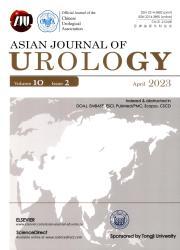2019-2023年伊朗国家转诊中心使用红外光谱测定肾结石成分
IF 2.4
3区 医学
Q2 UROLOGY & NEPHROLOGY
引用次数: 0
摘要
目的伊朗尿石症的全国终生患病率估计为6.6%。然而,关于肾结石成分的报道一直是基于化学分析等不精确的方法。在伊朗,以前没有基于金标准方法(x射线衍射或红外光谱)的大规模研究报告肾结石的组成。本研究旨在提供基于傅里叶变换红外光谱的肾结石成分。方法本研究是一项横断面研究,于2019年2月至2023年3月在伊朗各城市的转诊中心使用红外光谱评估尿石成分。结果本研究确定了来自伊朗10个城市的1092名患者的结石组成。总体而言,大多数结石由草酸钙组成(n=498;45.6%)和尿酸(UA, n=488;44.7%),其次是胱氨酸(n=49;4.5%)和鸟粪石(n=28;2.6%)。设拉子和伊斯法罕的石头组成大致相似,UA结石的比例较高(分别为53.4%和53.6%),而伊朗首都德黑兰的UA结石较少(39.9%),草酸钙结石的比例较高。UA结石的百分比随着年龄的增长而增加,儿童为11.1%,成人为42.7%,老年患者为83.3% (p<0.001)。约29.6%的胱氨酸结石见于儿童。结论伊朗肾结石中最常见的结石成分是草酸钙和UA结石。这种UA结石的相对频率大大高于许多来自邻国和遥远国家的国际报道。在儿童和妇女中观察到更多的胱氨酸结石。老年患者结石多由UA组成。本文章由计算机程序翻译,如有差异,请以英文原文为准。
Determination of the kidney stone composition using infrared spectroscopy in Iran at a national referral center during 2019–2023
Objective
The national lifetime prevalence of urolithiasis is estimated at 6.6% in Iran. However, reports on the composition of kidney stones have been based on imprecise methods like the chemical analysis. No prior large-scale study has reported the composition of kidney stones based on the gold-standard methods (X-ray diffraction or infrared spectroscopy) in Iran. This study aimed to provide the composition of kidney stones based on Fourier transform infrared spectroscopy.
Methods
This is a cross-sectional study assessing urinary stone composition from various cities in Iran at a referral center using infrared spectroscopy from February 2019 to March 2023.
Results
This study determined the stone composition of 1092 patients from 10 cities in Iran. Overall, the majority of stones were composed of calcium oxalate (n=498; 45.6%) and uric acid (UA, n=488; 44.7%) followed by cystine (n=49; 4.5%) and struvite (n=28; 2.6%). Stone composition in Shiraz and Isfahan was roughly similar with a higher percentage of UA stones (53.4% and 53.6%, respectively) while the capital city of Iran (Tehran) had less frequent UA stones (39.9%) with a higher percentage of calcium oxalate stones. The percentage of UA stones increased with age as it was 11.1% in children, 42.7% in adults, and 83.3% in geriatric patients (p<0.001). About 29.6% of cystine stones were observed in children.
Conclusion
The most frequent stone composition among kidney stones in Iran was calcium oxalate and UA stones. This relative frequency of UA stones is considerably higher than many international reports from neighboring as well as distant countries. More cystine stones were observed in children and women. Geriatric patients’ stones were mostly composed of UA.
求助全文
通过发布文献求助,成功后即可免费获取论文全文。
去求助
来源期刊

Asian Journal of Urology
UROLOGY & NEPHROLOGY-
CiteScore
4.00
自引率
3.80%
发文量
100
审稿时长
4 weeks
期刊介绍:
Asian Journal of Urology (AJUR), launched in October 2014, is an international peer-reviewed Open Access journal jointly founded by Shanghai Association for Science and Technology (SAST) and Second Military Medical University (SMMU). AJUR aims to build a communication platform for international researchers to effectively share scholarly achievements. It focuses on all specialties of urology both scientifically and clinically, with article types widely covering editorials, opinions, perspectives, reviews and mini-reviews, original articles, cases reports, rapid communications, and letters, etc. Fields of particular interest to the journal including, but not limited to: • Surgical oncology • Endourology • Calculi • Female urology • Erectile dysfunction • Infertility • Pediatric urology • Renal transplantation • Reconstructive surgery • Radiology • Pathology • Neurourology.
 求助内容:
求助内容: 应助结果提醒方式:
应助结果提醒方式:


